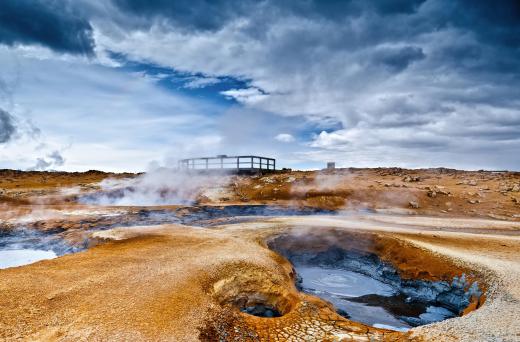How does Geothermal Power Generation Work?
 Michael Anissimov
Michael Anissimov
Geothermal power generation works by extracting energy from heat deep within the Earth. In some places, such as the islands of Iceland, the Philippines, and Japan, geothermal hot springs are common, making the energy easily accessible. In other places, sufficient heat is only found more than a mile (1.6 km) beneath the surface, making geothermal energy extraction impractical. Holes dug down to this level anywhere can usually be used to produce geothermal energy.
The first station for geothermal power generation was built on 4 July 1904, at the Larderello dry steam field in Italy and tested by Prince Piero Ginori Conti, making the use of geothermal power generation just over a century old. Still, geothermal power generation is not a major energy source worldwide, only making up about 0.1% of global power, or a capacity of around 100 gigawatts. Geothermal energy is only used extensively by the countries of the Philippines and Iceland, where they make up 15-20% of electricity generation.

The most common method of operation of a geothermal plant is the binary cycle, whereby moderately hot water from shallow geothermal heat sources is passed over pipes, called a heat exchanger, containing a secondary fluid — typically butane or pentane hydrocarbon — with a boiling point much lower than water. The heat causes the secondary fluid to flash to vapor, which drives turbines that generate electricity. The fluid is then recondensed and used for more cycles. The pressure of the secondary fluid is usually quite high, around 500 PSI.
Hot dry rock geothermal energy is another type of geothermal power generation; this method pumps water deep into the Earth, putting it in contact with the hot, dry rock that gives the method its name. The rock heats the water, which is then pumped out and used either directly with steam turbines, or pumped through a binary cycle system. Also known as Enhanced Geothermal Systems, these plants have a useful life of about 20 to 30 years before the rock cools down too far for the plant to be economical. Full heat recovers in 50-100 years.
Another type of geothermal power generation are flash steam plants. These plants pull hot, high-pressure water from deep in the Earth up into tanks, where the pressure drop causes the water to burst into steam, which is then used to turn turbines. One of the oldest types is direct heat, which pulls hot water from near the Earth's surface into pipes for use to heat buildings, heat water for fish farming, grow plants in greenhouses, pasteurize milk, etc. This only works in areas where sufficient hot water is available near the surface.
AS FEATURED ON:
AS FEATURED ON:











Discussion Comments
If one tenth the amount of government subsidy money given to nuclear and oil power development was given to geothermal, PV and wind, we could dispense with hydrocarbon and nuclear energy completely. Oil could then be used in a sustainable way as a lubricant, rather than a fuel.
Senator Bernie Sanders' Congressional study confirmed that over 12 billion dollars has been extracted from the US taxpayer on nuclear power plants that are supposedly private. Also, the so-called "oil depletion allowance", when added up would be a much higher figure.
We have been taken for a ride by con men with pollution and sickness as our reward.
I take issue with the 1.5 km requirement to get cost effective geothermal energy. Right now they are drilling for oil in the ocean at several times that depth and nobody is saying it's not 'cost effective'.
As the other poster here mentioned, a 30 to 70 percent reduction in heating and cooling costs can be easily achieved and that would erase any (contrived or otherwise) energy crisis or shortfall. Of course, that would force oil, gas and nuclear power corporations to cut their prices so perhaps that is why it hasn't happened yet.
@alchemy- A geothermal heat pump is much different from a geothermal power generator. Geothermal heating and cooling works by pumping a fluid through pipes or coils that are buried underground or sunken in a body of water. When the temperature of the building is below the subsurface temperature of the earth (50-55 degrees Fahrenheit), the water absorbs heat to be dissipated in the earth.
When the temperature of the building is below the earth's temperature the process works in reverse, dissipating the earth's heat into the building. This system essentially gives a building a base temperature to heat and cool from, creating less of a load for the traditional HVAC system. These systems save consumers between 30-70% on their heating and cooling bill depending on the geographic location and the area that needs to be heated or cooled.
How does geothermal heating and cooling work? How does it harness the earth's thermal energy to cool a home? How does geothermal heating and cooling save money?
Post your comments